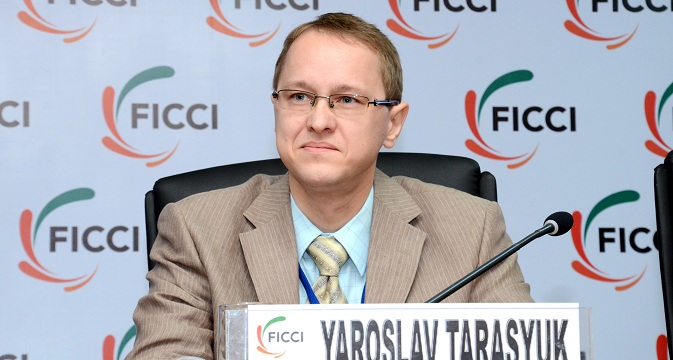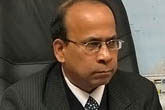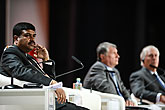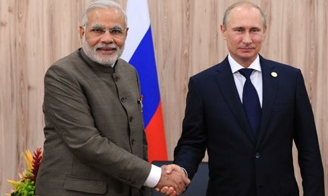‘Make in India’ quite well known in Russia

Yaroslav Tarasyuk, Russian Trade Representative in India. Source: Courtesy Trade Mission of Russian Federation in India
How do you assess the achievements of the new government of India in its first year? How are relations with Russia developing?
“The new government headed by Narendra Modi began implementing an ambitious package of measures and programmes aimed at stimulating economic development of the country. Ongoing measures involve streamlining public administration and improving the business and investment climate in the country.” (India ranks 142 in the World Bank’s Ease of Doing Business Report 2015. The government has set out to improve this rank by 50 spots).
“Under the government’s new major initiative – ‘Make in India’ – aimed at improving the productive capacity of the country, a new “single window” system has been introduced for the coordination of projects. Foreign investors are now able to invest in such important sectors of the Indian economy as the military-industrial complex, railways and insurance. Effective and transparent holding of auctions for the distribution of coalfields and mobile communications frequencies demonstrate the government’s constructive attitude when it comes to working with business. A very important achievement was an unprecedented increase in access to banking services for the poor people and the rural population. Serious measures have been taken to fight against money laundering and corruption.”
“I think that most important during the past year were the results achieved during the Russia-India Summit in December. The leaders of our countries, not only identified the main directions of work for the next decade in a joint “Friendship-Dosti” statement, but also set targets for mutual trade and investments. In addition, agreements reached between companies clearly show how we will achieve this multi-billion dollar growth in trade and investments. These are projects in the nuclear power industry, oil and gas, production of fertilizers, supply of rough diamonds, and what is especially important; cooperation in the manufacturing of products,” Tarasyuk said.
Is there interest in the ‘Make in India’ program on the part of Russia, in which sectors?
“I must say that the ‘Make in India’ initiative is already quite well known in Russia. Companies that come to India always study prospects for the localization of production, understanding full well that the Indian market is huge, but at the same time, also very competitive. Of course, in first place comes localization of production of machinery, equipment, components, and accessories – tractors and bulldozers, railway equipment, agricultural machinery, power and mining equipment, aviation equipment, and medical equipment.”
“Such projects are considered within the framework of the Joint Working Group on Priority Investment Projects under the leadership of the Russian Deputy Minister of Economic Development, Alexey Likhachev and India’s Deputy Minister of Trade and Industry, Amitabh Kant. The list of approved projects now contains 21 joint ventures. Among them are the production assembly of tractors in India by the Tractor Plants Concern, the creation of a joint venture for the development of helicopters based on the Ka-226T helicopter model, being implemented by Helicopters of Russia OJSC, the creation of a joint venture for the production of transformer steel by Novolipetsk Steel (NLMK) and Indian Rastriya Ispat Nigam Ltd (RINL), and others,” said Tarasyuk.
Analyzing the experience of functioning projects, including a joint venture of SIBUR and Reliance Industries, production assembly of KAMAZ trucks, the project by Lighting Technologies and others, what are the problems that could arise for Russian investors in India?
“I think all these projects are completely in line with the ‘Make in India’ programme, and these are also included in the list of Russia-India priority investment projects. The success of projects usually depends on several factors, including an understanding of the market conditions, the availability of finance and other resources, the selection of a reliable partner, the ability to anticipate and overcome problems. Attention must be paid to the need for careful consideration of issues involving labour legislation, taxation, land relations, and intellectual property rights,” the Trade Representative said.
In your opinion, how successful are the operations of Russian banks in India, do they have the capacity to support the necessary investments?
“I think the capacity of Russian banks, given their partnership status with Indian banks, is sufficient to support the investment activities of Russian companies in India. Operating in India today are branches of the Sberbank of Russia and VTB, as well as representative offices of Vnesheconombank, Gazprombank and Promsvyazbank. Actively working with Indian partners are the Zenit Bank and the Otkritie Financial Corporation."
Russia and India have considerable cooperation at the regional level. What regions of Russia and India are most active?
“This year, delegations from Stavropol and Astrakhan regions, headed by the governors, delegations of the Altai Territory, Khakassia, the Khanty-Mansi Autonomous Area, headed by vice-governors, and a delegation from the Tomsk Chamber of Commerce, all visited India. At the end of the year the delegation from Vladimir region is expected to visit. Moscow, St. Petersburg and Tatarstan are also actively working with India. Among the most important regional projects recently, I would like to mention the investment project of India's second largest producer of paints, Berger Paints, in the Stavropol region. It's about building a plant to produce 3,000 tons of paint per year with an investment of $5 million.”
For many years the countries have discussed, at different levels, the possibility of settlements in national currencies. Did the parties reach understanding of the mechanisms of such calculations?
“In April, at the recent meeting in India the sub-group on banking and financial issues, operating within the framework of the Intergovernmental Commission, analyzed the conclusions and recommendations of the Russia-India working group on bilateral settlements in national currencies. The authors of the report noted that there are no serious regulatory restrictions on settlement in rubles and rupees on sales contracts. Standard models of settlement which generally correspond to existing commercial practice of Russian and Indian banks were proposed. It was decided to initiate the discussion between the business communities of the two countries for a wider practical application of these models.”
“It should be noted that the Indian branch of Sberbank of Russia has already established the mechanism of settlements in national currencies. The volume of payments in Sberbank, the ‘rupee-ruble’ system topped $200 million, which is about 2% of the total trade turnover between the two countries,” the Russian TR said.
In December last year, India and Russia set a goal to increase trade turnover to $30 billion by 2025. How realistic are these figures, considering the current indicators?
“Speaking about the general situation in Russian-Indian trade, we have to state with regret that in January-April 2015, its volume continued to decline. According to the Federal Customs Service, bilateral trade decreased by 17.1% to $ 2.486 billion.
Russian exports decreased by 13.8% to $ 1.728 billion, and imports by 23.8%, to $ 758 million. Partially, this situation is linked to the volatility of the ruble, a sharp decline of demand in the Russian market, the drop of world energy prices, the reduction of the supply of coke, rough diamonds, certain types of electrical equipment and vehicles to India.”
“At the same time, in 2015 we see an increase in Russian exports of agricultural products, petroleum products, chemicals and fertilizers, newsprint, flat-rolled products, engines. We expect that during the year the situation will change for the better, and in 2016 the trade will shift into the trajectory of growth.
$30 billion in 2025- these figures can be justified by the agreements of the construction of nuclear power units, long-term contracts between Gazprom and Rosneft for the supply of LNG and crude oil, the increasing demand for Russian fertilizers and rough diamonds, agreements on industrial cooperation in the field of aircraft, helicopters, tractor construction, manufacturing of railway equipment.”
What is the status of the discussion for introduction of a free trade regime between India and the Eurasian Economic Community (EAEC) progressing?
“India already has free trade agreements with the ASEAN countries, Japan, the Republic of Korea and Sri Lanka. Having got to work, the new government of India has spent some time studying the effectiveness of such agreements for the development of India's exports. This caused the delay in the decision on the establishment of a working group of the Eurasian Economic Commission. We expect that the official start of work of the group will be given at the St. Petersburg International Economic Forum.”
In one of your interviews you mentioned that trade mission gets 15-20 requests daily for the supply of Russian goods and the search for partners for co-operation. In what areas of business is there the most interest? What hinders closer cooperation between Russian and Indian business?
“The greatest interest is shown by the manufacturers of medical equipment, fertilizers, including organic, various chemical products, metal products, equipment for purifying and improving water quality, energy equipment, railway equipment, tractors and bulldozers, optics and lasers.”
“I believe that sometimes the business lacks consistency and perseverance in the implementation of projects. Many interesting projects spring up as a result of participation in exhibitions and business missions. Unfortunately, after returning to Russia, obviously for a variety of reasons, projects get no development.”
“I think it would be wrong for the companies to refuse government support. Two extremes take place: companies that can not or do not want to do anything on their own, and those who do everything on their own, but once problems arise, still come to the trade mission. I am sure that the best would be constructive collaboration with the trade mission, the use of its resources, which is heavy artillery, not to fire on the wheel.
For example today, thanks to the Internet, one can get detailed information in a few hours about what analogies there are on the Indian market, who the competitors are, the size of import duty, etc. Most requests are about that, although the companies could easily get this information themselves. It's just the tip of the iceberg, but it still gives an idea about whether the company should try itself on the Indian market. Once there is understanding that Russian products will be competitive, it is appropriate to involve the trade mission,” Tarasyuk concluded.
All rights reserved by Rossiyskaya Gazeta.
Subscribe
to our newsletter!
Get the week's best stories straight to your inbox



